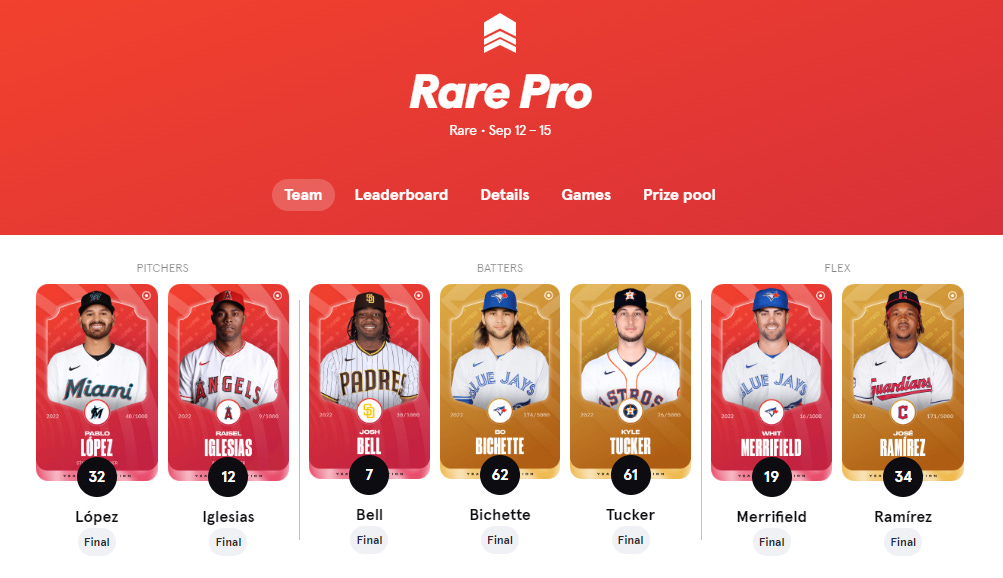Let's Talk About Stacks, Baby
How stacking players can spice up your Sorare MLB performance this season.
“Let’s talk about [Stacks], baby
Let’s talk about you and me
Let’s talk about all the good things
And the bad things that may be.”-Salt-N-Pepa
(If they were into Sorare MLB)
Musical intro taken care of - welcome to another pre-season dive into improving your Sorare MLB game in the upcoming season.
You can catch the first edition right here, where I outlined what I’d do differently if starting over in Sorare MLB ‘23. There is even a bit about stacks.
But today is all about Stacks.
In three simple parts:
What are they?
Why they matter?
How they can help you.
What is a Stack?
Those familiar with the concept are welcome to skip ahead to the next section.
But starting from first principles is never bad, so let’s go from square one:
A “stack” uses players from the same team or game to create a correlation in your lineup.
Seems pretty straightforward right?
Picking apart the definition we see two hows and a why. Your two ways, in general, to create a stack are with players from the same team or players from the same game.
Either way, the goal is to increase the correlation of the player performances (scores) in your lineup.
You do this because if you are right in your game (and player) selection, a good stack offers you a clear path to greater scoring upside for the week.

Why does this matter?
I can hear it now. Someone somewhere is shaking their head and telling their computer screen they can get a better-projected score each week by starting all their studs.
And you know what? They might be right.
Unfortunately for them, or fortunately for us, we don’t play a game where the highest median point projection automatically wins.
We also don’t play a game where everyone playing has the same access to capital - and therefore the same player base - to choose from.
This differs a bit from DFS where all players are subject to the same salary cap.
In Sorare MLB, our salary caps are a factor of our individual budgets, not the game itself (though point cap leagues over in NBA and Football add a wrinkle to this).
For now, we will keep it Baseball.
You, as an MLB manager are tasked with scoring the most possible points in relation to your peers.
That’s it.
That’s the game.
Bonus points if you can do that while avoiding economic ruin by not overextending your budget. But that’s a talk for another day.
With the name of the game firmly in place, the median point projection caveat from earlier floats back to mind as we look to how to use the concept.
How Stacking can help.
Ok, I promise I’ll get back to you crushing median projections with your stacks momentarily.
But first, an entirely made-up story to help de-mystify the point:
Imagine you are playing a game with your friends. One that involves them pitching a ball to you and you trying to hit it as far as you can.
But in this game you only get one swing.
Before stepping up to the plate, you are presented with two bat options:
Option 1: Nice, average wood bat. Smells like pine tar.
Option 2: Magic, thin, aluminum bat.
The wood bat is not unlike any you have seen before. You like the weight. You feel like you could hit decently far with it.
Here’s the catch, the aluminum bat breaks physics. It’s more like a lightsaber made solid. You can tell it will be tough to make contact with the ball. However, if you do, you somehow know you’d hit it a country mile.
You can feel it in your bones.
So… what do you choose for your one swing?
You probably saw through my thinly-veiled metaphor.
The wooden bat here is like a median projection. You, at your current skill level (budget), can probably make contact with your one pitch (lineup). And when you do, that contact might even be solid.
If you have been practicing, you might never need to think about the aluminum power rod. You are fine taking your swing.
Thats fine.
For Sorare purposes, that means you have a good, maybe great, roster that can comfortably hit upside scores for you regularly. You might do pretty well over time. With a big enough budget, you might even win a lot.
But most of us don’t live that life.
Most of us are playing this game against a team of professionals who take batting practice every day.
That brings us to the aluminum power rod again. This thing offers a mystical path to the distance you seek. All at the cost of hitting it out of the park or missing entirely.
One thing to be aware of: missing entirely is not much different than hitting a line drive out of the infield in this metaphor - neither of them results in you beating the pros.
By using what you’ve got in a more targeted way that correlates your players. when one has a good game, perhaps the others will. When one has a great matchup, the others do too. When one player is on base, you might well have the player up to the plate that hits a home run.
You see where I am going with this.
The potential positive variance of having multiple players from the same team (we’ll ignore the same game for now) opens you up to considerable upside.
Upside that is not present in a roster made entirely of high-median plays.
I’ve said a lot of words now.
All of them simply to say that building using stacks is a way to increase your upside while remaining at whatever budget level you play in.
But there is a tradeoff, which I alluded to earlier. Stacking also increases your downside. You can swing and miss easier. You might not score as many points week in and week out.
That is both normal and expected.
If you were playing against 1, 5, or even 10 other people, then putting your highest projected lineup out each week might make total sense.
But you aren’t.
You are playing against hundreds, often thousands of other competitors with unknown skill and budget levels. And only the top couple hundred participants win prizes.
Therin is our final key:
Only the top couple hundred participants win prizes.
Therefore, if you cannot afford to out-budget everyone, you should expect not to place often, regardless of your strategy.
Stacking offers a path for you to be really right - and perhaps take home some killer prizes - on the weeks that your stack pays off.
In other words, you accept a little more downside to have a shot at larger than normal upside. The silver lining here is that if a competition rewards the top 100 teams, the manager that comes in 101st gets the same prize as the manager who comes in 10,001st.
Nothing.
So the additional downside you take on doesn’t fundamentally alter your overall downside each week. While the additional upside can help give you a shot at the podium against people with far more resources than you.
As the gamblers in the room might say, that’s a plus EV bet.
Let’s Wrap it Up
First, thank you for bearing with me on this freeform rant.
I hope parts of it stick with you as a tool you can employ to find yourself an edge in this game we all know and love. An edge that gives you exposure to additional upside and glory.
Let’s chase those high-variance stacks to victory!





